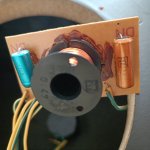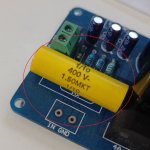I have a Philips FB297 model 3-way speaker. I wanted to change the electronic capacitors in the crossover circuit, but the capacitor shown in the picture (blue) which I thought was 1uf showed 4.5uf in the measurement. I was surprised. Old blue capacitor with 1u0 written on it. What could be the real value of this capacitor?
Sorry for my English. Thanks for any help.
Sorry for my English. Thanks for any help.
Attachments
Bipolar electrolytic capacitors like this one can increase in value as they age over time.
The correct value of the capacitor is 1.0 uF. Be sure to replace with a bipolar (non-polarised) type suitable for a loudspeaker crossover.
The correct value of the capacitor is 1.0 uF. Be sure to replace with a bipolar (non-polarised) type suitable for a loudspeaker crossover.
Yes- as Galu says- they have an aluminum electrolyte paste inside between the foil plates that can dry out, and the plates are closer together, and the capacitance value increases. Replace both capacitors- it look like the other one is a 4.7uF? Either pick a bipolar electrolytic that is a higher voltage if you can find it, or if you have a little money you can replace these with the correct value film crossover caps that will work a bit better and pretty much never deteriorate again.
Thank you for your valuable answers. I will probably use a polyester capacitor (yellow) like the one in the picture. If you think it will make a significant difference in sound quality, I can find a polypropylene one or if you have a better recommendation. The gold colored one is 4.7uf but when I measure it, it shows 5.6uf. Yes, a change is necessary.
Attachments
I agree with using a polyester capacitor.Thank you for your valuable answers. I will probably use a polyester capacitor (yellow) like the one in the picture. If you think it will make a significant difference in sound quality, I can find a polypropylene one or if you have a better recommendation. The gold colored one is 4.7uf but when I measure it, it shows 5.6uf. Yes, a change is necessary.
A polyester (mylar) film capacitor is better than an electrolytic capacitor, i.e., longer lasting, more stable value over time, self-healing characteristics (metalized polyester), lower dialectric absorption (DA), lower equivalent series resistance (ESR), etc. But, I doubt you would hear the difference between the two types of capacitors in a blind comparison, assuming they are the same value. Some people claim they can, but audibly the differences are very subtle.
Polypropylene is even better than polyester, but the differences between polypropylene and polyester are even smaller than the differences between polyester and electrolytic.
Yes- as Galu says- they have an aluminum electrolyte paste inside between the foil plates that can dry out, and the plates are closer together, and the capacitance value increases.
The electrolyte paste forms the negative plate of a wet electrolytic capacitor, while the aluminium oxide film on the positive foil is the dielectric.
It's interesting to examine the mechanisms that cause wet electrolytic capacitors to change value over time. Here's what I came up with:
If the electrolyte stays wet, but no voltage is applied for a long time - the caustic electrolyte etches into the oxide dielectric layer, the negative and positive plates effectively come closer together and the capacitance increases.
If the electrolyte dries out - the negative and positive plates effectively become further apart and the capacitance decreases.
I understand or have heard that if no voltage is applied for a long period of time, the electrolytic capacitor loses it's "form", and assume it would change in value, but I don't know which way. Bringing voltages up slowly can allow them to reform, and that the best condition is to sit frequently at ~2/3 rated voltage to remain in the best form and condition. You hear a lot of things, I'm never sure what is really accurate.
BTW rediceman- Check out the many styles of crossover caps at Parts Express ranging from affordable to boutique.
BTW rediceman- Check out the many styles of crossover caps at Parts Express ranging from affordable to boutique.
It may seem strange that many OLD electrolytics actually measure higher in value, but their Q and ESR are actually poor.
One thing that I don't quite understand is why brand-new bipolar electrolytics so often measure higher than their label ?
I would be interested in a post regarding this.
One thing that I don't quite understand is why brand-new bipolar electrolytics so often measure higher than their label ?
I would be interested in a post regarding this.
Very valuable information. Thank you. While electronic capacitors may look nice in a circuit, it is probably best to avoid using them if possible.I agree with using a polyester capacitor.
A polyester (mylar) film capacitor is better than an electrolytic capacitor, i.e., longer lasting, more stable value over time, self-healing characteristics (metalized polyester), lower dialectric absorption (DA), lower equivalent series resistance (ESR), etc. But, I doubt you would hear the difference between the two types of capacitors in a blind comparison, assuming they are the same value. Some people claim they can, but audibly the differences are very subtle.
Polypropylene is even better than polyester, but the differences between polypropylene and polyester are even smaller than the differences between polyester and electrolytic.
If it's a BP electrolytic you better replace it with the same. That's how you will restore the original sonic qualities of the speaker & it'll last another 10-15years without any problem.
If I build new speaker by myself of course polypropylene or mkt would be my first choice.
If I build new speaker by myself of course polypropylene or mkt would be my first choice.
Last edited:
No. That is not good advice.If it's a BP electrolytic you better replace it with the same. That's how you will restore the original sonic qualities of the speaker
The vast majority of people will hear no sound difference between a polyester and an electrolytic capacitor if they are the same value.
But, therein lies the problem. Electrolytic capacitors are notorious for poor tolerances. Polyester capacitors tend to be much more consistent.
Those that claim to hear a sound difference typically claim that polyester capacitors are more transparent and detailed in comparison to electrolytics. If we assume they really do hear a difference, regardless of how subtle it is, that would be explaned by the lower DA of the polyester capactitors.
Do you really think Philips managed to save a lot of money by not using 1uf film instead of 1uf bipolar electrolytic?! I hve seen many modern hifi components system using the same. Sony, Philips, Aiwa, you name it.
I think if a Philips executive could save a penny per speaker by standing on his head, he would.
Electrolytic caps were likely cheaper and more available at the time. I always see electrolytics in the cheap and cheesy (and I have seen a LOT) and film capacitors in the high end stuff. You're darn right they saved money or they would not have done it.
Electrolytic caps were likely cheaper and more available at the time. I always see electrolytics in the cheap and cheesy (and I have seen a LOT) and film capacitors in the high end stuff. You're darn right they saved money or they would not have done it.
There are only two reasons to use electrolytics that I know of, low cost and high density (i.e., small package for a given capacitance value and voltage rating). In all other aspects plastic film (e.g., polyester, polypropylene, polycarbonate, etc.) capacitors are better.Do you really think Philips managed to save a lot of money by not using 1uf film instead of 1uf bipolar electrolytic?! I hve seen many modern hifi components system using the same. Sony, Philips, Aiwa, you name it.
Absolutely. $0.1 multiplied by a million pays for a very nice bonus for the purchasing guy.Do you really think Philips managed to save a lot of money by not using 1uf film instead of 1uf bipolar electrolytic?! I hve seen many modern hifi components system using the same. Sony, Philips, Aiwa, you name it.
Hello again. I think the only reason why companies insist on electronic capacitors is profit. I watched a few videos on youtube today about crossovers. One of them caught my attention and I am sharing it here. I will share the changes in the sound when I change the electronics in my Philips speakers. If I am satisfied with the application, I am considering the same process for Dali Zensor 3. Thanks to those who helped.
It's an interesting video. The impedance sweep measured before and after shows what I have found in my experience, lots of fill in the cabinet is effective. The effectiveness of this fill is proportional to its density, so the poly fill is the least effective type. If more damping is required rock wool or packed fiberglass batting has higher density. Placing acoustic damping material on the walls is the least effective location for it as the velocity of the air is zero perpendicular to the wall at the surface and velocity is required for the damping to have any effect. Heavy viscous damping materials on the wall or additional bracing is effective at changing panel resonances. As there were no measurements before and after the coil change, this is not conclusive in my opinion. It would be easy to do distortion measurements with the iron core and then the air core and overlay them. In many applications the power required to saturate a properly sized iron core inductor is so high that the woofer distortion is larger at those excursions and dominates the sonic signature.
1uF is small enough that you could replace it with a non-electrolytic cap, such as a Mylar or polypropylene type of cap, which have no polarization at all. A 50V or more voltage rating would be adequate.Bipolar electrolytic capacitors like this one can increase in value as they age over time.
The correct value of the capacitor is 1.0 uF. Be sure to replace with a bipolar (non-polarised) type suitable for a loudspeaker crossover.
- Home
- Design & Build
- Parts
- Crossover capacitor definition


